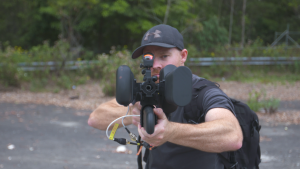News and Commentary.
Recently, my phone has been ringing off the hook (or out of my pocket, I’m not that old) with reporters of the general media asking for commentary on the latest airport disruption.
Over and over, I have had to explain that “just shooting them down” is not only a very poor idea, but also among the least effective of drone mitigation possibilities. Moreover, I have repeated ad nauseam my personal view that as there are already plenty of laws in existence clearly prohibiting anyone, using any method whatsoever, from interfering with airlines there is no particular benefit in creating a new and more emphatic set of laws specific to drones. However, the question then remains: what could airports do to limit drone access?
There are many “anti-drone” or “counter drone” technologies – or rather, just drone control technologies – that can prevent drone incursions. (I’m not sure that “anti-drone” is a good term – these technologies are part of the drone industry: and they’re the industry’s best shot at avoiding damaging regulations.)
Some look like something out of Mad Max – like the Drone Gun from DroneShield. When Queensland pledged to form a special drone police unit equipped with the Drone Gun, Liberal Party Leader Tim Nicholls called them “ray guns” on TV. The Drone Gun doesn’t require a bullet to put down a drone, it just cuts the signal. While the Drone Gun is the bit that provides the great photo opps, it’s part of a larger and more sophisticated system that uses multi-sensor analysis to detect and identify drones, alerting the appropriate personnel who may then use a tool like the Drone Gun to bring the drone to the ground.
“Bringing a drone down” – whether its with a ray gun or a shot gun – has some disadvantages. It’s expensive. It breaks the drone and payload, which could be embarassing or expensive if a drone’s been grounded by mistake. It’s a dramatic solution to what can sometimes by a very mundane problem of an inexperienced pilot letting their drone get away from them. Nonetheless, its thorough.
Dedrone is another well-known drone control technology, the one chosen to protect the World Economic Forum in Davos last year. They also offer detection and identification software – but Dedrone proposes that facilities choose reasonably between a “passive” approach and an “active” approach to drone mitigation. A passive approach doesn’t try to take the drone down, it just closes down the vulnerable areas of the protected site to limit the damage, which might be totally appropriate for a commercial or certain infrastructure sites. An active approach allows for the integration of mitigation tools like the Drone Gun to bring the intruder down.
A third type of drone control technology takes a different approach. The system from Airspace uses different tools to detect, identify and mitigate drones. In the vein of “it takes one to know one,” Airspace uses another drone – equipped with a net – to take down the intruder. Jaz Banga, Airspace’s CEO, describes the system as one of enabling commercial drone application – by allowing only proper access to the appropriate airspace, much like a keypass system allows only authorized employees into a building.
There are many more. Eagles trained to take drones down. The British AUDS system. The recent problem at airports isn’t a lack of drone control technology, its that airports and other facilities weren’t previously in much of a rush to issue their RFIs, hire their consultants, go through their proof of concept trials, issue an RFP, select a vendor and finally, go through an implementation process. If the average implementation time of an ERP system runs from 6 months to 2 years, it doesn’t seem unreasonable to expect that large entities like airports may be running a bit behind the technology in their implementation cycles.
I’d be willing to bet that they’ve sped up in the last month or so. The soone the anti-drone technologies are in place, the sooner the commercial drones can get to work in those spaces without worries.
Miriam McNabb is the Editor-in-Chief of DRONELIFE and CEO of JobForDrones, a professional drone services marketplace, and a fascinated observer of the emerging drone industry and the regulatory environment for drones. Miriam has a degree from the University of Chicago and over 20 years of experience in high tech sales and marketing for new technologies.
Email Miriam
TWITTER:@spaldingbarker
Subscribe to DroneLife here.
https://dronelife.com/2019/01/25/3-ways-drones-can-be-kept-out-of-airports-with-or-without-a-lot-of-drama/
 Unmanned Aerial Vehicle The latest drone news
Unmanned Aerial Vehicle The latest drone news




